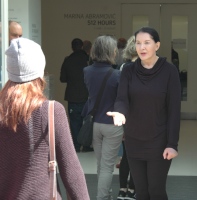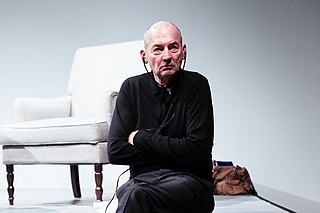
Remment Lucas Koolhaas is a Dutch architect, architectural theorist, urbanist and Professor in Practice of Architecture and Urban Design at the Graduate School of Design at Harvard University. He is often cited as a representative of Deconstructivism and is the author of Delirious New York: A Retroactive Manifesto for Manhattan.

Dame Zaha Mohammad Hadid was an Iraqi-British architect, artist and designer, recognized as a major figure in architecture of the late-20th and early-21st centuries. Born in Baghdad, Iraq, Hadid studied mathematics as an undergraduate and then enrolled at the Architectural Association School of Architecture in 1972. In search of an alternative system to traditional architectural drawing, and influenced by Suprematism and the Russian avant-garde, Hadid adopted painting as a design tool and abstraction as an investigative principle to "reinvestigate the aborted and untested experiments of Modernism [...] to unveil new fields of building".
The year 2004 in architecture involved some significant architectural events and new buildings.

Maggie's centres are a network of drop-in centres across the United Kingdom and Hong Kong, which aim to help anyone who has been affected by cancer. They are not intended as a replacement for conventional cancer therapy, but as a caring environment that can provide support, information and practical advice. They are located near, but are detached from, existing NHS hospitals.
Starchitect is a portmanteau used to describe architects whose celebrity and critical acclaim have transformed them into idols of the architecture world and may even have given them some degree of fame among the general public. Celebrity status is generally associated with avant-gardist novelty. Developers around the world have proven eager to sign up "top talent" (i.e., starchitects) in hopes of convincing reluctant municipalities to approve large developments, of obtaining financing or of increasing the value of their buildings. A key characteristic is that the starchitecture is almost always "iconic" and highly visible within the site or context. As the status is dependent on current visibility in the media, fading media status implies that architects lose "starchitect" status—hence a list can be drawn up of former "starchitects".

Olafur Eliasson is an Icelandic–Danish artist known for sculptured and large-scaled installation art employing elemental materials such as light, water, and air temperature to enhance the viewer's experience.

Contemporary architecture is the architecture of the 21st century. No single style is dominant. Contemporary architects work in several different styles, from postmodernism, high-tech architecture and new references and interpretations of traditional architecture to highly conceptual forms and designs, resembling sculpture on an enormous scale. Some of these styles and approaches make use of very advanced technology and modern building materials, such as tube structures which allow construction of buildings that are taller, lighter and stronger than those in the 20th century, while others prioritize the use of natural and ecological materials like stone, wood and lime. One technology that is common to all forms of contemporary architecture is the use of new techniques of computer-aided design, which allow buildings to be designed and modeled on computers in three dimensions, and constructed with more precision and speed.
Dame Julia Peyton-Jones is a British curator and gallery director, currently Senior Global Director at Galerie Thaddaeus Ropac in London, Paris and Salzburg. She formerly worked as Co-Director of the Serpentine Gallery in London.

Kvadrat is a Danish textile company that produces and supplies textiles and textile-related products to architects, designers and private consumers in Europe and worldwide. Kvadrat was established in Denmark in 1968 with deep roots in Scandinavia's design tradition.
Junya Ishigami is a Japanese architect.

MAXXI is a national museum of contemporary art and architecture in the Flaminio neighborhood of Rome, Italy. The museum is managed by a foundation created by the Italian ministry of cultural heritage. The building was designed by Zaha Hadid, and won the Stirling Prize of the Royal Institute of British Architects in 2010.

Iwan Baan is a Dutch photographer. He has challenged a long-standing tradition of depicting buildings as isolated and static by representing people in architecture and showing the building's environment, trying "to produce more of a story or a feel for a project" and "to communicate how people use the space". He has photographed buildings by many of the world's most prominent architects, including Rem Koolhaas and Toyo Ito. He is "one of the most widely published" photographers in the world. His candid "polysemic shots" have been compared to the work of Diane Arbus.
The year 2011 in architecture involved some significant architectural events and new buildings.
AKT II is a London based firm of structural, civil and transportation engineering consultants. It was founded as Adams Kara Taylor in 1996 by Hanif Kara, Albert Williamson-Taylor and Robin Adams. Now numbering over 350 employees, it is one of the largest structural engineers in London.
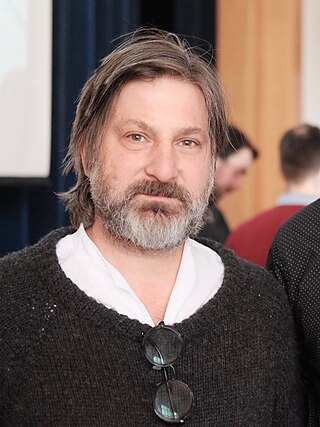
Smiljan Radic is an internationally recognised Chilean architect of Croatian heritage. Radic graduated in 1989 in architecture at the Catholic University of Chile and established his own office in 1995. Many of his projects are small scale, such as dwellings and installation designs that bridge across various cultural traditions. Radic was selected to design the 2014 Serpentine Gallery Pavilion in London.
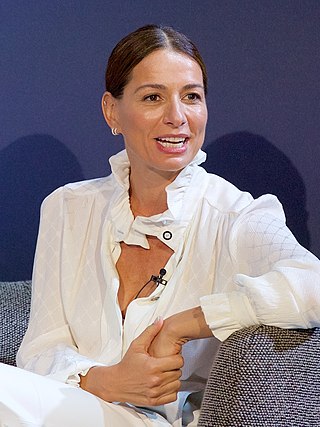
Yana Peel is a Russian-born Canadian executive, businesswoman, children's author and philanthropist who is currently global head of arts and culture at French fashion house Chanel. She was CEO of the Serpentine Galleries from 2016 to 2019, and was previously a board member.
Amira Gad is an Egyptian art curator, writer, and editor in modern and contemporary art and architecture who was born in France but grew up in Saudi Arabia. Most recently, she was Head of Programs at Light Art Space (LAS), a private foundation based in Berlin (2020-2023).
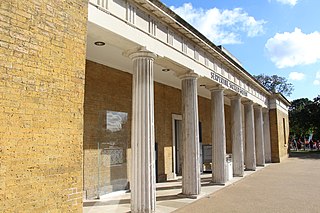
Serpentine North or Serpentine North Gallery is a listed building in Hyde Park, London, which, with the South Gallery, constitutes the Serpentine Galleries, an art exposition space. It was originally known as The Magazine, and also, from 2013 to 2021, as the Serpentine Sackler Gallery. Since 2013, the name The Magazine specifically refers to an extension of the building, a restaurant designed by architect Zaha Hadid.
The Swiss Architectural Award is an international architecture award.

The Vitra Fire Station is a concrete and steel building of 852 m2 (9,170 sq ft) located at the Vitra Furniture factory in Weil am Rhein, Germany. Completed in 1993, it was the first constructed project by Iraqi architect Zaha Hadid.



